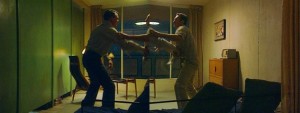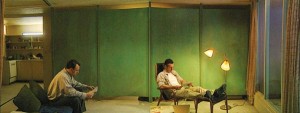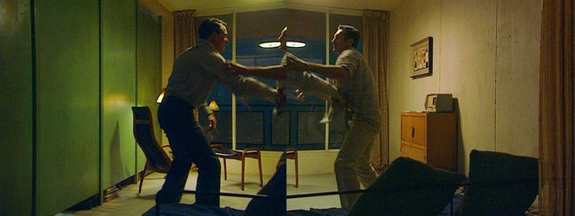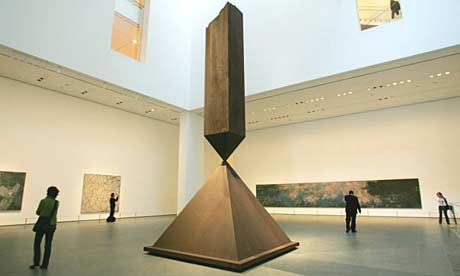The past several years have seen major international survey exhibitions devoted to the vast and varied subject of re-enactment in contemporary art.
Cheap Wall Decorations looked at the phenomenon in its previous issue, albeit in the more expanded context of immersion. It’s not just artists and curators who seem eager to stage performances of historical texts and events, but a wide range of participants, including hobbyists’ war play, lay historians and heritage industry practitioners, filmmakers, and, last to join the fray, academics. The field is trendy to the point of saturation, which might explain my initial scepticism about Re-enactments, a comparatively modest exhibition at
Montreal’s DHc/Art.
The foundation’s curator, John Zeppetelli, hedges his bets from the get-go, situating the show between two re-enactors par excellence, Jeremy Deller and Marina Abramovic. The familiar contexts of “popular” re-enactment, the kind Deller appropriates in his famous Battle of Orgreave (2001), and the live “re-performances” of artworks in Abramovic’s Seven Easy Pieces (2005) are positioned as points of departure in an exhibition that takes a nuanced approach to artistic engagement with cultural referents and reactivated memories.
Stan Douglas’ Inconsolable Memories (2005), is perhaps the most satisfying inclusion, as he was notably absent from previous re-enactment exhibitions such as Life, Once More (Witte de With, 2005) and History Will Repeat Itself, (Kunst-Werke Berlin, 2007-2008). Douglas is an artist with an ongoing interest in the remake. In the case of this work–and others, such as Journey In to Fear (2001)–timeframes are shifted and geopolitical contexts significantly altered. In Journey, Douglas applies this method to Tomas Guiterrez Alea’s Cuban classic, Memories of Underdevelopment (1968); where the original film was set against the Bay of Pigs invasion of 1962, the remake takes place in the updated context of the Mariel boat exodus of 1980, in which thousands of Cubans were allowed to escape to Florida. Paralleling the film’s narrative of physical and temporal displacement, the installation’s technical apparatus embodies its own mode of performed re-enactment, a component of Douglas’ practice that dates back to Overture (1986). Here, Douglas’ trademark ‘recombinant narrative’ is deployed using two alternating 16mm film loops projected on one screen, conceptually and technically extending the exhibition’s theme. Narrative is remade, reactivated and made alien to the viewer, who can never access the whole story.


Crossing the street from the DHC’S satellite space to its main building, I met another mechanized, yet embodied performance in Danish artist Ann Lislegaard’s I-You-Later-There (2000). A woman’s voice, multiplied and overlaid in a manner both mesmerizing and unsettling, describes an interior space in which everyday gestures are enacted. Simultaneously, and in synch with the vocal enunciations and background noises, a halogen light flickers against a leaning screen that resembles a square section of stage. Slightly nauseated by the play of optical and audio effects, I was nonetheless compelled to mentally reconstruct the speaker’s location. The narration and effects of light offered an indirect means to do this, animating the space and prompting associations between speech and visualization. The piece is unique in the show, in that it lacks a pre-existing cultural reference–narration is instead the point of origin for another kind of live re-enactment, this time performed by the viewer in an activated physical space.
Lislegaard’s configuration of re-enactment as a cognitive process, whereby history is recovered by mentally restaging received information, nicely links to Kerry Tribe’s video work several floors above. Here & Elsewhere (2002), a two-channel projection, takes up related theoretical tropes of memory and temporal rearrangement. Tribe’s re-enactment is twofold: first, the piece is a remake of Jean-Luc Godard and Anne-Marie Mieville’s television series France/tour/detour/deux/enfants (1978), a 12-part documentary project in which two children are asked ideological or philosophical questions. Tribe orchestrates a similar question-and-answer session between a hidden, authoritative figure, and a child subject, visible onscreen. But in Tribe’s work, the crucial difference is that the child, Audrey Wollen, is actually the daughter of her erudite interrogator, British film historian and theoretician Peter Wollen.
It is this familial link, introduced via the remake, which is most compelling in Tribe’s work. The question and answer format used is of the original, but its meaning shifts within this new, intimate context. Tensions emerge as Audrey reacts to ontological questions (which themselves reflect notions of cognitive re-enactment) with a mix of candour and seemingly programmed responses. I couldn’t help but infer ideas about Audrey’s relationship with her father–the kinds of daily conversations that would produce the child’s cool, at times playful responses to questions like, “do you remember the last time, when we talked of existing and existence?” As a result, the idea of the “remake” as a frame of reference for the work fades in significance. The pseudo-ethnographic present eclipses the re-enacted past.
In a show about returns, it is appropriate that the work on view has all been seen elsewhere. At the DHC, works by Nancy Davenport and Lislegaard are significantly altered in their reinstallations. In some cases, such as Paul Pfeiffer’s Live Evil (Bucharest) (2004), the works are amplified by their new context. Pfeiffer’s tiny projection, split between adjoining walls, shows Michael Jackson’s legs performing his signature moonwalk while his head and torso are grotesquely distorted by superimposition. Where the work has been criticized in the past for being excessively technical, here it strikes just the right note as an introduction to the same artist’s aggressive Live From Neverland (2007), in which a chorus of boys and girls chants a script culled from Jackson’s televised plea of innocence to accusations of child molestation, and the piece grows more sinister by association.
Down the hall, Harun Farocki’s Deep Play (2007) visually trumps Pfeiffer’s work. The piece, recently shown at Documenta, could be considered the anti-Zidane: A 21st-Century Portrait (2006)–the widely seen video by Douglas Gordon and Philippe Parreno about the eponymous soccer player. Gone is the romance of the alienated artist as articulated in Gordon and Parreno’s big-budget sensation. Farocki’s work instead unveils the technical apparatus that underlies the totalizing culture of “soccer is life” Twelve projected monitors render technically multiple aspects of the play on both sides of the 2006 World Cup Final, offering digital renderings, surveillance footage, even Laban notations. Re-enactment, pace Deller and Abramovic, is conceived not as a literal re-performance of the visible components of past events, but rather as an uncovering and visualization of covert elements that were subsumed within their original, spectacular form. This departure from such conventional modes of re-enactment is what keeps the show as a whole from lapsing into survey territory, as was the case with some of the past exhibitions that dealt with this theme. Instead, re-enactment is positioned as an open-ended theoretical model that unsettles our relationships with cultural texts, embodied experiences and collective memories.
Related articles:
http://www.purevolume.com/listeners/goodwalldecorations/posts 
 Crossing the street from the DHC’S satellite space to its main building, I met another mechanized, yet embodied performance in Danish artist Ann Lislegaard’s I-You-Later-There (2000). A woman’s voice, multiplied and overlaid in a manner both mesmerizing and unsettling, describes an interior space in which everyday gestures are enacted. Simultaneously, and in synch with the vocal enunciations and background noises, a halogen light flickers against a leaning screen that resembles a square section of stage. Slightly nauseated by the play of optical and audio effects, I was nonetheless compelled to mentally reconstruct the speaker’s location. The narration and effects of light offered an indirect means to do this, animating the space and prompting associations between speech and visualization. The piece is unique in the show, in that it lacks a pre-existing cultural reference–narration is instead the point of origin for another kind of live re-enactment, this time performed by the viewer in an activated physical space.
Lislegaard’s configuration of re-enactment as a cognitive process, whereby history is recovered by mentally restaging received information, nicely links to Kerry Tribe’s video work several floors above. Here & Elsewhere (2002), a two-channel projection, takes up related theoretical tropes of memory and temporal rearrangement. Tribe’s re-enactment is twofold: first, the piece is a remake of Jean-Luc Godard and Anne-Marie Mieville’s television series France/tour/detour/deux/enfants (1978), a 12-part documentary project in which two children are asked ideological or philosophical questions. Tribe orchestrates a similar question-and-answer session between a hidden, authoritative figure, and a child subject, visible onscreen. But in Tribe’s work, the crucial difference is that the child, Audrey Wollen, is actually the daughter of her erudite interrogator, British film historian and theoretician Peter Wollen.
It is this familial link, introduced via the remake, which is most compelling in Tribe’s work. The question and answer format used is of the original, but its meaning shifts within this new, intimate context. Tensions emerge as Audrey reacts to ontological questions (which themselves reflect notions of cognitive re-enactment) with a mix of candour and seemingly programmed responses. I couldn’t help but infer ideas about Audrey’s relationship with her father–the kinds of daily conversations that would produce the child’s cool, at times playful responses to questions like, “do you remember the last time, when we talked of existing and existence?” As a result, the idea of the “remake” as a frame of reference for the work fades in significance. The pseudo-ethnographic present eclipses the re-enacted past.
In a show about returns, it is appropriate that the work on view has all been seen elsewhere. At the DHC, works by Nancy Davenport and Lislegaard are significantly altered in their reinstallations. In some cases, such as Paul Pfeiffer’s Live Evil (Bucharest) (2004), the works are amplified by their new context. Pfeiffer’s tiny projection, split between adjoining walls, shows Michael Jackson’s legs performing his signature moonwalk while his head and torso are grotesquely distorted by superimposition. Where the work has been criticized in the past for being excessively technical, here it strikes just the right note as an introduction to the same artist’s aggressive Live From Neverland (2007), in which a chorus of boys and girls chants a script culled from Jackson’s televised plea of innocence to accusations of child molestation, and the piece grows more sinister by association.
Down the hall, Harun Farocki’s Deep Play (2007) visually trumps Pfeiffer’s work. The piece, recently shown at Documenta, could be considered the anti-Zidane: A 21st-Century Portrait (2006)–the widely seen video by Douglas Gordon and Philippe Parreno about the eponymous soccer player. Gone is the romance of the alienated artist as articulated in Gordon and Parreno’s big-budget sensation. Farocki’s work instead unveils the technical apparatus that underlies the totalizing culture of “soccer is life” Twelve projected monitors render technically multiple aspects of the play on both sides of the 2006 World Cup Final, offering digital renderings, surveillance footage, even Laban notations. Re-enactment, pace Deller and Abramovic, is conceived not as a literal re-performance of the visible components of past events, but rather as an uncovering and visualization of covert elements that were subsumed within their original, spectacular form. This departure from such conventional modes of re-enactment is what keeps the show as a whole from lapsing into survey territory, as was the case with some of the past exhibitions that dealt with this theme. Instead, re-enactment is positioned as an open-ended theoretical model that unsettles our relationships with cultural texts, embodied experiences and collective memories.
Related articles: http://www.purevolume.com/listeners/goodwalldecorations/posts
Crossing the street from the DHC’S satellite space to its main building, I met another mechanized, yet embodied performance in Danish artist Ann Lislegaard’s I-You-Later-There (2000). A woman’s voice, multiplied and overlaid in a manner both mesmerizing and unsettling, describes an interior space in which everyday gestures are enacted. Simultaneously, and in synch with the vocal enunciations and background noises, a halogen light flickers against a leaning screen that resembles a square section of stage. Slightly nauseated by the play of optical and audio effects, I was nonetheless compelled to mentally reconstruct the speaker’s location. The narration and effects of light offered an indirect means to do this, animating the space and prompting associations between speech and visualization. The piece is unique in the show, in that it lacks a pre-existing cultural reference–narration is instead the point of origin for another kind of live re-enactment, this time performed by the viewer in an activated physical space.
Lislegaard’s configuration of re-enactment as a cognitive process, whereby history is recovered by mentally restaging received information, nicely links to Kerry Tribe’s video work several floors above. Here & Elsewhere (2002), a two-channel projection, takes up related theoretical tropes of memory and temporal rearrangement. Tribe’s re-enactment is twofold: first, the piece is a remake of Jean-Luc Godard and Anne-Marie Mieville’s television series France/tour/detour/deux/enfants (1978), a 12-part documentary project in which two children are asked ideological or philosophical questions. Tribe orchestrates a similar question-and-answer session between a hidden, authoritative figure, and a child subject, visible onscreen. But in Tribe’s work, the crucial difference is that the child, Audrey Wollen, is actually the daughter of her erudite interrogator, British film historian and theoretician Peter Wollen.
It is this familial link, introduced via the remake, which is most compelling in Tribe’s work. The question and answer format used is of the original, but its meaning shifts within this new, intimate context. Tensions emerge as Audrey reacts to ontological questions (which themselves reflect notions of cognitive re-enactment) with a mix of candour and seemingly programmed responses. I couldn’t help but infer ideas about Audrey’s relationship with her father–the kinds of daily conversations that would produce the child’s cool, at times playful responses to questions like, “do you remember the last time, when we talked of existing and existence?” As a result, the idea of the “remake” as a frame of reference for the work fades in significance. The pseudo-ethnographic present eclipses the re-enacted past.
In a show about returns, it is appropriate that the work on view has all been seen elsewhere. At the DHC, works by Nancy Davenport and Lislegaard are significantly altered in their reinstallations. In some cases, such as Paul Pfeiffer’s Live Evil (Bucharest) (2004), the works are amplified by their new context. Pfeiffer’s tiny projection, split between adjoining walls, shows Michael Jackson’s legs performing his signature moonwalk while his head and torso are grotesquely distorted by superimposition. Where the work has been criticized in the past for being excessively technical, here it strikes just the right note as an introduction to the same artist’s aggressive Live From Neverland (2007), in which a chorus of boys and girls chants a script culled from Jackson’s televised plea of innocence to accusations of child molestation, and the piece grows more sinister by association.
Down the hall, Harun Farocki’s Deep Play (2007) visually trumps Pfeiffer’s work. The piece, recently shown at Documenta, could be considered the anti-Zidane: A 21st-Century Portrait (2006)–the widely seen video by Douglas Gordon and Philippe Parreno about the eponymous soccer player. Gone is the romance of the alienated artist as articulated in Gordon and Parreno’s big-budget sensation. Farocki’s work instead unveils the technical apparatus that underlies the totalizing culture of “soccer is life” Twelve projected monitors render technically multiple aspects of the play on both sides of the 2006 World Cup Final, offering digital renderings, surveillance footage, even Laban notations. Re-enactment, pace Deller and Abramovic, is conceived not as a literal re-performance of the visible components of past events, but rather as an uncovering and visualization of covert elements that were subsumed within their original, spectacular form. This departure from such conventional modes of re-enactment is what keeps the show as a whole from lapsing into survey territory, as was the case with some of the past exhibitions that dealt with this theme. Instead, re-enactment is positioned as an open-ended theoretical model that unsettles our relationships with cultural texts, embodied experiences and collective memories.
Related articles: http://www.purevolume.com/listeners/goodwalldecorations/posts 
